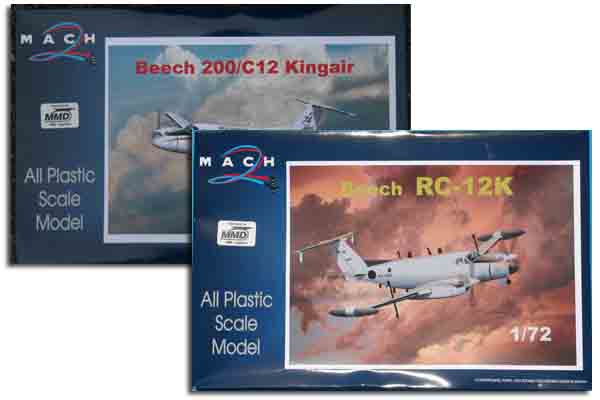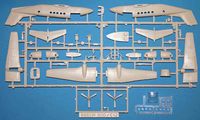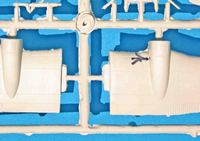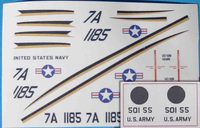
Mach 2 1/72 Beech 200/C-12 Super King Air/Huron & RC-12K SIGINT
By Chellie M. Lynn
History
Launched by Beechcraft in 1969 as the Model 101, as a development of the Beech 100 King Air, the Super King Air featured a revised rear fuselage to accommodate a T-tail in place of the Model 100's conventional layout. The fuselage was also modified to withstand a higher pressure differential. The first flight was on October 27, 1972. Many different versions of the King Air were produced for multiple civil and military uses. There are at least 40 different military designations related to the Super King Air that I have been able to locate. The USAF is starting a search for a replacement for the C-12 Fleet, although the only bird that meets all the requirements is the current Hawker/Beechcraft King Air 350.
The Kits
 Opening the box reveals the typical Mach 2 single sprue for the color parts and a second smaller sprue for the clear parts. Parts are mostly well formed with decent engraved detail. The smaller parts suffer from large attachment points and significant flash. The only downside is the rough surface texture of all parts including the clear ones. I am uncertain as to how the molds are made or whether they are metal or ceramic.
Opening the box reveals the typical Mach 2 single sprue for the color parts and a second smaller sprue for the clear parts. Parts are mostly well formed with decent engraved detail. The smaller parts suffer from large attachment points and significant flash. The only downside is the rough surface texture of all parts including the clear ones. I am uncertain as to how the molds are made or whether they are metal or ceramic.
 Common flaws of the Mach 2 kits are visible mold cracks and a thing I call the Blort. The Blort is an area large or small somewhere on the main parts of the kit where a distortion has occurred leaving an irregular bulge, usually on an exterior surface. Finding the Blort is always one of my first goals when surveying a new Mach 2 kit, as its size and location will impact assembly of the kit. Between the rough surface texture and the Blort, Mach 2 kits always provide an interesting challenge. I do not hold these minor annoyances against Mach 2 as the small amount of sanding and polishing is quite worth it to me to have kits that no one else would even consider. The previously mentioned Blort is to be found on the right wing leading edge at the nacelle juncture (see picture).
Common flaws of the Mach 2 kits are visible mold cracks and a thing I call the Blort. The Blort is an area large or small somewhere on the main parts of the kit where a distortion has occurred leaving an irregular bulge, usually on an exterior surface. Finding the Blort is always one of my first goals when surveying a new Mach 2 kit, as its size and location will impact assembly of the kit. Between the rough surface texture and the Blort, Mach 2 kits always provide an interesting challenge. I do not hold these minor annoyances against Mach 2 as the small amount of sanding and polishing is quite worth it to me to have kits that no one else would even consider. The previously mentioned Blort is to be found on the right wing leading edge at the nacelle juncture (see picture).
The kits include a very basic cockpit consisting of a floor, rear bulkhead with the door open, a very plain and somewhat misshaped instrument panel that is to be attached to an inner fuselage bit. Two rather crude control wheels and very basic seats complete the interior. There is no passenger/crew compartment detail in either kit, although the very thick cloudy transparencies likely won't allow much if anything to be seen.
 The primary difference in these two kits lies in the two additional sprue sections that include the wing tip tanks and all the extra antennas for the Army Guardrail version. Also included on these sections are the four bladed propellers introduced on the C-12s from model D onwards. From my research it appears that the various U.S. military branches did not fully standardize on the prop configuration until the early 1980s. However, to this day, I still occasionally see C-12s with the 3 bladed props. All of the additional antennas will need careful cleanup as the plastic is the typical Mach 2 brittle ivory.
The primary difference in these two kits lies in the two additional sprue sections that include the wing tip tanks and all the extra antennas for the Army Guardrail version. Also included on these sections are the four bladed propellers introduced on the C-12s from model D onwards. From my research it appears that the various U.S. military branches did not fully standardize on the prop configuration until the early 1980s. However, to this day, I still occasionally see C-12s with the 3 bladed props. All of the additional antennas will need careful cleanup as the plastic is the typical Mach 2 brittle ivory.
The instructions are typical of Mach 2, meaning excruciatingly simplified with locations of many small parts left open to question. The best guidance I can give is to find pictures of your desired prototype and mount the odds & bods based on personal research.
 The Super King Air/Huron comes with decent U. S. Navy markings for a staff transport C-12. The RC-12K features U. S. Army markings and all the extra bumps and blades for the Guardrail SIGINT version. As the durability and ease of use of Mach 2 decals frequently leaves a bit to be desired, I try to have alternate backup markings available. I have some appropriate RAAF and RNZAF decals in store so one or both may end up with aftermarket markings.
The Super King Air/Huron comes with decent U. S. Navy markings for a staff transport C-12. The RC-12K features U. S. Army markings and all the extra bumps and blades for the Guardrail SIGINT version. As the durability and ease of use of Mach 2 decals frequently leaves a bit to be desired, I try to have alternate backup markings available. I have some appropriate RAAF and RNZAF decals in store so one or both may end up with aftermarket markings.
Accuracy
Overall these kits scale out very close to published data from Hawker/Beechcraft and other sources. Wing chord might be a bit short, but is not serious enough to warrant correction. Overall it looks like a King Air and that is the important part to me.
Conclusion
Mach 2 kits are not for the beginner, and the more experience the better. I actually enjoy most of the Mach 2 kits I have built over the years and these 2 actually appear to be eminently buildable in a reasonable time. With the large number of military operators (at least 46 different countries) and the resultant plethora of possible markings, equipment, and color schemes, a significant fleet could be built up. However at about $50 a pop, I may have to settle for a much more limited number.
I obtained my kits at Skyway Model Shop, as Emil seems to know my preferences quite well, and has the new Mach 2 kits as soon as they are available.
